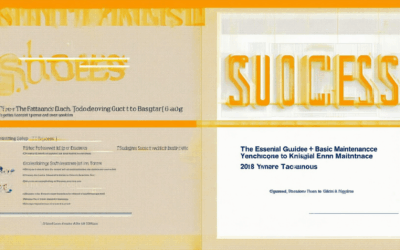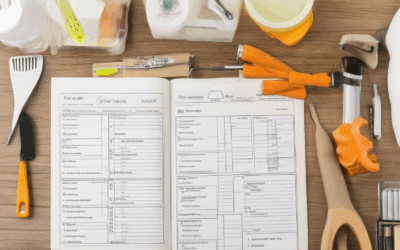“Keeping your home in top shape doesn’t have to be overwhelming. A well-structured yearly home maintenance checklist can help you tackle tasks efficiently, preventing minor issues from escalating. The 1% rule is a simple yet effective strategy to maintain your property, ensuring everything stays in great condition. Whether you’re looking to stay organized, prepare for seasonal changes, or know when professional assistance is needed, this checklist covers it all. Say goodbye to unexpected repairs and hello to a well-maintained home with our comprehensive guide.”
- Master Home Maintenance with a Well-Organized Checklist: Create a structured checklist to streamline your home upkeep.
- Adopt a 1% Rule Approach: Focus on high-impact tasks to maximize efficiency.
- Personalize Your Plan: Tailor your maintenance routine to fit your unique lifestyle and home size.
- Stay Proactive with Scheduled Tasks: Implement a monthly and annual maintenance schedule.
- Keep It Simple and Effective: Concentrate on high-priority areas to maintain order.
- Leverage Technology for Efficiency: Utilize apps and smart devices to manage tasks effortlessly.
- Involve Family Members: Distribute responsibilities to enhance teamwork and reduce burden.
- Prepare for Seasons with Adjusted Tasks: Adapt your routine to address seasonal concerns naturally.
- Prioritize Energy Efficiency and Safety: Enhance your home’s comfort and security through targeted efforts.
- Hire Experts When Needed: Seek professional help for complex tasks to ensure quality outcomes.

What Maintenance Does a House Need Every Year?
Annual home maintenance is crucial to ensure your property remains in great shape and avoids costly repairs. Here’s a detailed checklist to guide you through the essential tasks:
- Exterior Maintenance
- Inspect and repair roof for missing shingles or damage.
- Check siding for cracks, peeling, or damage.
- Examine windows and doors for proper sealing and functionality.
- Clean and check gutters and downspouts for blockages.
- Inspect decks, porches, and walkways for structural issues.
- Pressure wash exterior surfaces to remove dirt and grime.
- Interior Maintenance
- Check floors for warping, cracking, or unevenness.
- Inspect walls for peeling paint or water damage.
- Test smoke detectors and carbon monoxide alarms.
- Check plumbing for leaks under sinks, toilets, and showers.
- Clean and service appliances like the washer, dryer, and stove.
- Inspect water heater for rust or corrosion.
- Heating, Ventilation, and Air Conditioning (HVAC)
- Clean or replace air filters monthly and annually depending on usage.
- Inspect ductwork for leaks or blockages.
- Schedule a professional tune-up for your furnace or heat pump.
- Check the thermostat for proper programming and functionality.
- Plumbing and Water Systems
- Check for leaks around pipes and fixtures.
- Inspect underground pipes for damage or root intrusion.
- Test water pressure and ensure there are no discolored water issues.
- Flush water heaters to prevent sediment buildup.
- Electrical Systems
- Inspect circuit breakers and fuse boxes for damage or tripping.
- Check outlets and switches for overheating or malfunction.
- Ensure GFCIs (Ground Fault Circuit Interrupters) are installed and functioning.
- Test lighting fixtures and fans for proper operation.
- Landscape and Outdoor Features
- Inspect trees and shrubs for signs of disease or pests.
- Trim bushes and trees to maintain visibility and prevent encroachment.
- Check for dead branches that could fall and cause damage.
- Inspect outdoor lighting for functionality and safety.
- Ensure drains and sprinklers are working properly.
- Reseal driveways, patios, and walkways as needed.
- Additional Tips
- Hire a professional inspector to catch issues you might miss.
- Use a comprehensive checklist to stay organized.
- Stay informed about local building codes and regulations.
By tackling these tasks annually, you’ll extend your home’s lifespan and ensure it remains safe and comfortable for years to come. Regular maintenance also helps prevent unexpected repair costs and keeps your home looking its best!
Learn more about comprehensive home maintenance or explore our full range of services to keep your home in top shape.
The 1% Rule for Home Maintenance
The 1% rule is a handy guideline for estimating annual home maintenance costs. Here’s how it works:
- Calculate 1% of Your Home’s Value: Determine 1% of your home’s appraised value. For example, if your home is worth $200,000, you’d set aside $2,000 annually.
- Allocate Funds Wisely: Use this amount for routine tasks like gutter cleaning, HVAC inspections, and minor repairs. This ensures you’re prepared for unexpected issues without overspending.
- Consider Home Condition: Adjust your allocation based on your home’s age and unique needs. Older homes may require more frequent maintenance, while newer ones might need less.
- Plan for Emergencies and Projects: Reserve a portion for unexpected repairs and planned improvements, balancing both emergency funds and long-term projects.
This rule provides a flexible framework, allowing you to adapt your maintenance strategy to suit your specific circumstances and home requirements.

What Maintenance Is Required for a House?
To keep your house in great shape, regular maintenance is crucial. Here’s a comprehensive guide to ensure your home stays in optimal condition:
Seasonal Maintenance
Adopt a seasonal approach to home care:
- Spring Maintenance:
- Check the roof for missing shingles or damage.
- Inspect gutters and downspouts for clogs and leaks.
- Prune trees and bushes to maintain clearance.
- Clean out fireplaces and chimneys.
- Summer Maintenance:
- Test air conditioning performance and replace filters.
- Examine windows for cracks or drafts.
- Check outdoor lighting and electrical systems.
- Service lawn equipment before mowing season begins.
- Fall Maintenance:
- Gutter cleaning to prevent blockages from leaves.
- Check for trip hazards like loose boards or stones.
- Prepare pipes for freezing weather by insulating or draining.
- Service heating systems before colder weather arrives.
- Winter Maintenance:
- Inspect chimneys and flues for damage or blockages.
- Check for water leaks around windows and doors.
- Service snow removal equipment if needed.
- Prepare lawns by applying winter protectants.
Year-Round Home Care Tips
Stay proactive with these ongoing maintenance tasks:
- Exterior Checks:
- Paint peeling siding or repaint exterior surfaces as needed.
- Inspect decks for rot or structural issues.
- Trim overhanging branches to maintain safety.
- Interior Cleaning:
- Dust and vacuum regularly to prevent dust buildup.
- Maintain carpets through spot cleaning and professional cleaning schedules.
- Check for mold or mildew in bathrooms and basements.
- Appliance Care:
- Scheduled maintenance for HVAC systems to ensure efficiency.
- Regularly clean and service major appliances like refrigerators and dishwashers.
- Inspect smoke detectors and carbon monoxide alarms monthly.
- Plumbing Systems:
- Bleeding faucets to prevent leaks and drips.
- Checking for slow drains and clogs in pipes.
- Testing water pressure and ensuring no unusual noises indicate pipe issues.
- Electrical Systems:
- Inspect circuit breakers and fuse boxes for damage or tripping issues.
- Check for exposed wires or loose connections.
- Replace outdated wiring as needed to prevent fires or shocks.
Additional Tips for Long-Term Home Care
Preventative measures can save you from costly repairs later:
- Regular Inspections:
- Hiring professionals to inspect chimneys, roofs, and foundations annually.
- Using thermal imaging to detect hidden issues in walls or attics.
- Weather-Proofing:
- Sealing windows and doors to reduce energy loss and drafts.
- Installing weatherstripping around doors and windows.
- Grading property to prevent water pooling near the foundation.
- Landscaping:
- Keeping grass and plants trimmed to prevent overgrowth.
- Clearing debris from gutters and downspouts.
- Inspecting walkways for cracks or uneven surfaces.
By staying on top of these maintenance tasks, you’ll enjoy a safe, comfortable, and well-maintained home year-round. Remember to schedule regular check-ups and address issues promptly to avoid costly repairs and extend your home’s lifespan.

How to Maintain a Home Checklist
A well-organized home checklist is essential for keeping your living space in excellent shape. Here’s a step-by-step guide to creating and maintaining one that works for you:
Key Components of a Successful Home Checklist
- Daily Tasks: Tidy up rooms, wash dishes, and ensure all living areas are clean and functional.
- Weekly Cleaning Schedule: Dust furniture, vacuum floors, and declutter storage spaces to prevent clutter buildup.
- Monthly Inspections: Check for signs of wear and tear, test appliances, and inspect plumbing systems.
- Annual Maintenance: Replace filters, service HVAC systems, and perform routine checks on major appliances.
Creating a Personalized Checklist
Personalize your checklist based on your lifestyle and home size. Consider the following:
- Frequency of Use: High-use items may require more frequent attention.
- Family Involvement: Involve household members in maintaining shared spaces.
- Seasonal Adjustments: Adapt tasks according to weather conditions, like preparing for winterizing your home.
Monthly Home Maintenance Checklist
Stay organized with a monthly breakdown of tasks:
- January: Deep clean bathrooms and kitchens.
- February: Service heating systems and check pipes.
- March: Clean gutters and inspect windows.
- April: Prepare outdoor spaces for spring.
- May: Test smoke detectors and water hoses.
- June: Clean out attics and basements.
- July: Check for pests and repair fencing.
- August: Service AC units and trim trees.
- September: Clean out fall debris.
- October: Inspect for damage after storms.
- November: Prepare for winter events.
- December: Deep clean before holidays.
Additional Tips for Success
- Use Technology: Implement smart home devices for reminders and automation.
- Rotate Responsibilities: Assign tasks to family members to share the workload.
- Keep It Simple: Focus on high-priority areas to avoid overwhelm.
- Review Regularly: Update your checklist annually to reflect changes in your home or routines.
Conclusion
Maintaining a home checklist can transform your living environment, ensuring longevity and functionality. By staying proactive, you’ll save time and money in the long run. Keep it tailored to your needs and adapt it as your circumstances change.
For more detailed guides and resources, visit our Home Maintenance Checklist Guide .
General House Maintenance
General house maintenance refers to the routine tasks and activities required to keep a residential property in good condition. These tasks are essential for preserving the value of the home, ensuring safety, and preventing costly repairs. Below is a comprehensive guide to various aspects of house maintenance.
Key Components of House Maintenance
- Safety Checks: Regularly inspect for potential hazards such as loose floorboards, exposed wires, or damaged railings. Ensure smoke detectors and carbon monoxide alarms are functioning properly.
- Cleaning: Maintain cleanliness in all areas of the house, including bathrooms, kitchens, and living spaces. Dusting, vacuuming, and mopping floors regularly helps prevent dirt buildup and allergens.
- Rodent Control: Inspect for signs of pests like mice or rats and seal entry points to prevent infestations. Use traps or professional services as needed.
- Garbage Disposal: Clean and maintain the garbage disposal unit regularly to prevent clogs and odors. Run it periodically with hot water to flush out debris.
- Gardening and Landscaping: Trim trees and bushes, mow the lawn, and maintain flower beds to keep the exterior of the house looking neat and healthy.
- Asset Repairs: Address minor repairs immediately, such as fixing leaky pipes, replacing worn-out caulking, or repairing loose shingles on the roof.
Seasonal Maintenance Tips
Seasonal maintenance plays a crucial role in preserving the integrity of your home. Here are some tips tailored to different seasons:
Spring Maintenance
- Check for damage caused by winter weather, such as cracked sidewalks or roof damage.
- Clean and service air conditioning units to ensure optimal performance during the warmer months.
- Inspect gutters and downspouts for clogs and ensure they are directed away from the house.
Summer Maintenance
- Test and recharge fire extinguishers to prepare for grilling season or other cooking activities.
- Service outdoor equipment like lawnmowers and trimmers to ensure they are ready for use.
- Check for and treat any ant or insect infestations around the property.
Winter Maintenance
- Seal windows and doors to improve energy efficiency and reduce drafts.
- Prepare the HVAC system for winter by cleaning vents and ducts and checking the furnace.
- Stock up on rock salt and sand for snow and ice removal.
Monthly Maintenance Tasks
Establishing a monthly maintenance routine can help keep your home in great shape year-round. Here are some tasks to include:
- Month 1: Check for plumbing leaks and test smoke detectors.
- Month 2: Service the heating system and clean out gutters.
- Month 3: Inspect the electrical system and prune trees near power lines.
- Month 4: Test the sump pump and clean the chimney flues.
Annual Maintenance Projects
Some house maintenance tasks are best handled once a year to ensure longevity and safety. These projects include:
- Painting Exterior: Refresh the appearance of your home with a fresh coat of paint every few years.
- Deck Inspection and Repair: Replace warped or rotten boards and re-stain the deck as needed.
- Roof Inspection: Look for missing shingles or damage caused by weather.
- Flooring Maintenance: Refinish hardwood floors or replace carpeting as necessary.
Energy Efficiency and Safety
Don’t overlook the importance of energy efficiency and home security in your maintenance routine. Consider upgrading to energy-efficient appliances and installing security systems to protect your family and belongings.
Professional Help When Needed
While many maintenance tasks can be handled by homeowners, some require specialized skills and tools. Don’t hesitate to hire professionals for tasks like HVAC repair, plumbing, or roofing to ensure they’re done correctly and safely.
By staying proactive with regular maintenance, you can save money, extend the life of your home, and enjoy a safer, more comfortable living environment. Remember to review this guide annually and adjust your maintenance plan as needed to suit your family’s needs.

How to Organize Your Home Maintenance
To effectively manage your home maintenance, follow these organized strategies:
- Schedule Regular Check-ins: Use a digital calendar like Google Calendar or Microsoft 365 Calendar to set reminders for recurring tasks such as gutter cleaning, lawn mowing, and HVAC system checks.
- Categorize Tasks:** Create a categorized checklist divided into sections like “Kitchen,” “Bathroom,” “Yard,” and “Appliances.” This helps in breaking down tasks into manageable groups and ensures nothing is overlooked.
- Seasonal Reminders:** Note down seasonal tasks in your calendar. For instance, set reminders for gutter cleaning in autumn and lawn fertilization in spring using apps like Cozify .
- Appliance Maintenance:** Check manufacturer guidelines for maintenance intervals and set reminders for services like washer, dryer, and HVAC system maintenance. Consider hiring professionals for complex tasks via platforms like ServiceMagic .
- Safety Inspections:** Regularly inspect devices like smoke detectors, CO detectors, and security systems. Schedule these checks quarterly using your digital calendar.
- Monthly Review Sessions:** Conduct monthly reviews to adjust your maintenance plan and prepare for upcoming tasks. Mark completed items on your checklist to stay motivated.
- Hire Professionals When Needed:** For challenging tasks, consider hiring experts listed on platforms like Handyman to ensure reliability and efficiency.
By integrating these strategies, you can maintain a balanced and effective home maintenance routine, ensuring everything runs smoothly without stress.




0 Comments